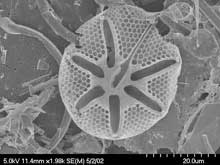Articles and reports from the Life Sciences and chemistry area deal with applied and basic research into modern biology, chemistry and human medicine.
Valuable information can be found on a range of life sciences fields including bacteriology, biochemistry, bionics, bioinformatics, biophysics, biotechnology, genetics, geobotany, human biology, marine biology, microbiology, molecular biology, cellular biology, zoology, bioinorganic chemistry, microchemistry and environmental chemistry.

Scientists at the University of Pennsylvania School of Medicine have identified and described a small gene that regulates the delicate balance involved in the healthy growth and replication of heart muscle cells.
“This finding is likely to be important for our understanding of the causes of congenital heart disease. It is also relevant to our attempts to regrow damaged heart muscle,” said the corresponding author of the study, Jonathan A. Epstein, MD, of Penn’s Departments of Medicine a

Eavesdropping among animals influences their behavior, Lee Dugatkin, an evolutionary biologist at the University of Louisville, has found.
Dugatkin and a colleague, Ryan Earley of Georgia State University, studied eavesdropping among male swordtail fish they placed in an experimental tank. They put two fish on one side of a partition and a lone observer male on the other. In some cases, the partitions were clear and in others, opaque.
The fish that could observe their potential adve

Why live in a glass house? For diatoms — tiny ocean-dwelling organisms that live in exquisitely ornate glass cases — the benefit turns out to be enormous.
In a paper published in the Sept. 13 issue of Science, Princeton scientists show that diatoms probably depend on glass to survive because the material facilitates photosynthesis. However, their study suggests that this domestic arrangement has a much bigger beneficiary: the entire planet, which owes its present-day, oxygen-rich and carbo

Using x-ray crystallography, researchers have produced the first images of a large molecular complex that helps shape and load the small, bubble-like vesicles that transport newly formed proteins in the cell. Understanding vesicle “budding” is one of the prerequisites for learning how proteins and other molecules are routed to their correct destinations in the cell.
In an article published in the September 19, 2002, issue of the journal Nature, Howard Hughes Medical Institute (HHMI) investi

Knowing an organism’s genome is good, but knowing what turns on its genes is even better.
Scientists have long searched for triggers that activate ribonucleic acid (RNA), a key component in gene expression. Now, in the Thursday, Sept. 19 issue of the journal Nature, scientists from the University of Wisconsin-Madison report that they have found an enzyme that activates RNA, which could lead to new ways of regulating genetic information.
“One of the big questions in molecular

Two scientists at The Scripps Research Institute (TSRI) have described how a plant grown in their laboratory uses two sets of proteins to detect the seasons so that it can flower at the right time. And by tinkering with those proteins, the scientists were able to make the plant flower at will.
“We have demonstrated, for the first time, how plants can anticipate the seasons so that they can flower appropriately,” says Marcelo Yanovsky, Ph.D., who is a research associate at TSRI and the lead